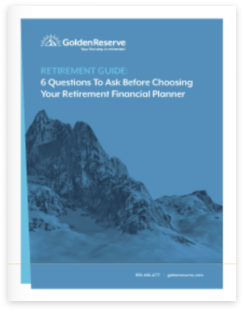Debunking the Retirement Myth: You Don’t Need 2 Million Dollars
Feeling that nagging doubt about your retirement savings? You’re not alone. A recent study found just 49%…
Golden Reserve

Ever wondered how much your financial advisor is really pocketing from your retirement nest egg? Are you suspicious of those fees they’re charging? Let’s dive deep into the murky waters of financial advisor compensation and uncover the secrets they might not be sharing. We’ll expose the three most common fee structures advisors use and question whether they truly prioritize your best interests in retirement.
Financial Advisors can make money in a number of ways, including:
–Percentage fees: This is the most common way that financial advisors charge fees. They charge a percentage of your account value, typically around 1-2%. This means that the more money you have in your account, the more the advisor will make.
–Commissions: Financial advisors can also earn commissions by selling you investment products, such as mutual funds. These commissions can be a significant amount of money, and they can create a conflict of interest for the advisor, as they may be incentivized to sell you products that are not in your best interest.
–Other fees: Financial advisors may also charge other fees, such as hourly fees or planning fees.
Why are advisor fees a problem?
Advisor fees can pose significant challenges for retirees. First, these fees can be surprisingly expensive. For instance, a seemingly modest 1% fee on a $1 million retirement account translates to $10,000 annually – a hefty sum that could total $250,000 over a 25-year retirement! Second, these fees can be frustratingly opaque, often hidden within automatic deductions, making it difficult to track exactly how much you’re paying. Finally, and perhaps most concerning, these fees can create a conflict of interest. Advisors earning a percentage of your account value might be incentivized to discourage withdrawals, even if that means you miss out on enjoying your hard-earned retirement funds. Ultimately, they’re taking a pay cut if you start spending your money. So, when choosing an advisor, prioritize finding one who aligns with your retirement goals and offers a transparent fee structure that puts your interests first.
An alternative fee structure:
A flat fee structure is a fairer way for retirement planners to charge retirees. A flat fee is a fixed fee that is charged regardless of the size of your account. This can help to ensure that you are not paying more in fees simply because you have more money saved. This can help alleviate the concern of conflict of interest.
Understanding how your advisor gets paid is a crucial step towards a secure and worry-free retirement. By choosing an advisor who prioritizes your best interests, you’ll be encouraged to spend your savings on the things that truly matter: taking dream vacations, updating your home, and finally tackling that bucket list. The right retirement planner won’t just manage your money, they’ll empower you to live your best retirement life to the fullest.

Share this article
Feeling that nagging doubt about your retirement savings? You’re not alone. A recent study found just 49%…
“When should you start taking Social Security?” ranks among the top questions researched by retirees. Social Security…
Retirement is a time to relax and enjoy the fruits of your labor. But how do you…
Retirement should be a time of relaxation and enjoyment, not financial stress or regret. Unfortunately, many retirees…